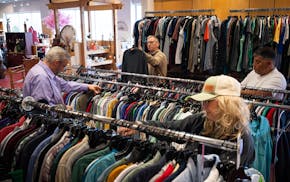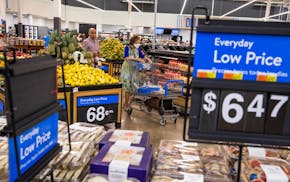Legacy Thrift, a used goods store in Crystal, has seen an unprecedented upswing in business over the last two months, with sales sometimes reaching $10,000 a day. And Chairman Ronn Kreps is pretty sure he knows why more people are shopping secondhand.
"Whether inflation is slowing down or not, whether tariffs are going to impact prices, whether supply chain issues are hitting them, people are concerned about how their money is getting spent, and just trying to spend it wisely," Kreps said.
Legacy Thrift isn't the only local secondhand store experiencing a surge in sales.
A half dozen people who run thrift stores across the Twin Cities metro said in interviews that foot traffic has noticeably picked up, though some couldn't say for sure whether decisions at the White House are driving the trend.
Still, early signs suggest the current economic climate could give thrifting a boost. The Trump administration's on-again, off-again tariffs have ratcheted up economic anxiety — and prices of some items, with the cost of clothing imported from foreign fast-fashion retailers on the rise.
But Adele Meyer, the executive director of the National Association of Retail and Thrift Shops, said it's too early to say if Trump's trade war will compel more people to purchase used goods.
"The tariff thing is still a moving target," she said. "Any time we have a downturn in the economy, it takes a while until you really know how consumers are going to react."
Still, Meyer noted that other disruptive events have helped the secondhand retail industry in the past: People purchased used goods to save money amid the 2008 recession, and the pandemic produced a minor renaissance in pre-owned furniture sales as people reconfigured their homes for lockdown.
Current economic volatility could lead to another growth spurt for an industry that's already expanded tremendously in recent years, as young people and eco-friendly shoppers continue to swell the ranks of thrifters.
But Meyer cautioned that the picture for secondhand stores might not be entirely rosy.
"Businesses are going to see an increase in their expenses, too," she said, predicting that "prices are going to go up."
Thrift stores see growth
Jesse Lara, the manager of Local Imports, said the Shakopee thrift store tends to attract certain demographic groups; middle-aged, middle-class women searching the aisles for good deals and unique items and young people on the hunt for chunky sweaters and vinyl records.
In recent months, though, Lara said he's noticed an increase in a different clientele — families in need of affordable home goods and clothing.
"I think it's to stretch their budgets a little more," he said of the multigenerational shoppers flocking to the nonprofit store, which is operated by the social services CAP Agency.
Lara doesn't plan to raise prices at Local Imports, which sells everything from used designer handbags to children's books. A major draw for customers — and one he wants to maintain — is single-point pricing. That means certain collections of items, like jeans and sweaters, cost the same regardless of style or size.
"So no matter what you find in the rack, you know how much it's going to be," said Lara, a Shakopee City Council member.
Plenty of consumers might find comfort in that consistency.
The president's April "Liberation Day" announcement sent the S&P tumbling. Meanwhile, the taxes on goods imported from China, Mexico and Canada have been met with pauses from federal judges, attempts to halt those pauses, exemptions and retaliatory tariffs.
The economy contracted by 0.2 percent in the first quarter of 2025 — two quarters of negative growth typically signals a recession — and U.S. consumer confidence sharply declined earlier this year before rebounding recently.
That's all adding up to possible price hikes on some items, including clothes.
A June report from the Yale University Budget Lab states tariffs have led to short-term price increases of 28% for apparel. But while big-box stores including Target have increased some prices to offset the impact of tariffs, many second-hand stores haven't resorted to drastically higher mark-ups.
"The economic climate certainly seems to be helping us," said Kreps of the nonprofit Legacy Thrift. The shop has slightly raised prices amid inflation, he added, but they remain lower than other for-profit stores.
'Embodied experiences'
As Americans shop less frequently at traditional retailers, Twin Cities second-hand stores are feeling the fallout in different ways. At Flying Pig Thrift in St. Paul, foot traffic has increased while donations have declined.
"It seems like people are holding onto things a little bit longer, or thinking a little bit more about whether they actually want to get rid of them," assistant manager Jude Lindemann said.
Customer behavior is also changing. People scouring the store for low-cost household goods have partially supplanted the Hamline University students who typically patronize Flying Pig to casually browse.
Jens Paulson, the manager of Hidden Treasures in Saint Anthony, said business has steadily ticked up in the nearly two decades since the store has been open. Some of those shoppers are trying to pinch pennies. "Thrift stores are at the nexus of difficult life circumstances," he said.
But for others, the urge to shop secondhand has nothing to do with economics.
"I think people are looking for things that bring them into embodied experiences," he said. "When the news feels unstable, it's nice to be an actual brick and mortar place to come and do some grounding."

Rural Minnesota school bus driver is a teacher as much as chauffeur

Twin Cities thrift stores are having a moment. Are tariffs pushing people to shop secondhand?
Minnesota's med spa industry rises in popularity — and with little regulation

Ramstad: Readers say Walmart won't be paying the ultimate price of Trump's tariffs

